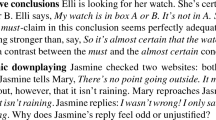Abstract
The paper suggests a modal predicate logic that deals with classical quantification and modalities as well as intermediate operators, like “most” and “mostly”. Following up the theory of generalized quantifiers, we will understand them as two-placed operators and call them determiners. Quantifiers as well as modal operators will be constructed from them. Besides the classical deduction, we discuss a weaker probabilistic inference “therefore, probably” defined by symmetrical probability measures in Carnap’s style. The given probabilistic inference relates intermediate quantification to singular statements: “Most S are P” does not logically entail that a particular individual S is also P, but it follows that this is probably the case, where the probability is not ascribed to the propositions but to the inference. We show how this system deals with single case expectations while predictions of statistical statements remain generally problematic.



Similar content being viewed by others
Notes
Singe case expectations are also the focus of default reasoning, where an inference is prima facie rational, but might be refuted when more is known. When Reiter (1980) established default logic, he stated: “A good deal of what we know about a world is ‘almost always’ true, with a few exceptions. Such facts usually assume the form “Most P’s are Q’s” or “Most P’s have property Q” (Reiter 1980, p. 82). The default pattern he introduces, e.g. \(\frac{\mathrm {BIRD}(x): \mathsf {M}\mathrm {FLY}(x)}{\mathrm {FLY}(x)}\) (read: If x is a bird and it is consistent to assume that x flies, then conclude that x flies), however, has little to do with the semantics of “most” or quantities at all. This was later pointed out by Reiter himself (cf. Reiter 1987) and defeasible reasoning is up to now rarely seen as statistical reasoning.
For details on ISOM and isomorphic structures cf. Peters and Westerstahl (2006, p. 98f.).
For a definition cf. Peters and Westerstahl (2006, p. 138).
This is the common textbook analysis of the natural language term “most”. One might object that this borderline is artificial. But this line, i.e. more than a half, is the logical minimal requirement that captures some essential properties of “most”, for example contrariety. “MOST S are P” and “MOST S are not P” are obviously not compatible. Both statements are wrong if exactly half of the S are P.
For Carnap’s remarks on classificatory, comparative and quantitative terms, see (Carnap 1962, p. 8ff.).
The model is in general open to sophistications and more restricted interpretations, e.g. as a tense logic.
The reference of a closed sentence doesn’t depend on a particular world. Thus, the subscript is dropped.
Cf. e.g. Benthem (2003).
Generally, there is not one particular m but many different measures that comply with the definition. Carnap’s initial ambition was to use further constraints in order to single out one particular measure, e.g. by expanding symmetry from a requirement for instantiations of one statistical distributions to symmetry that even all of those should be measured equally. This assumptions is however highly controversial (cf. Hájek 2012, ch. 3.2) and also not necessary for our purposes. We consider all m that accord to individual symmetry and regularity.
\(MOST (p\vee \lnot p)\) means “mostly”. It is not restricted by particular cases.
The type of quantifiers states the number of terms and variables that are bound simultaneously. A quantifier of type \(\langle 1\rangle\) has one argument and binds one variable. The discussed determiners of DLP have type \(\langle 1,1\rangle\). They have two arguments and bind one variable for each. If two arguments are taken and for each argument two variables are bound simultaneously, then the quantifier has type \(\langle 2,2\rangle\) etc.
References
Adams EW (1974) The logic of ‘almost all’. J Philos Log 3:3–17
Adams EW (1975) The logic of conditionals. An application of probability to deductive logic. D. Reidel Publishing Company, Dodrecht
Barwise J, Cooper R (1981) Generalized quantifiers and natural language. Linguist Philos 4:159–219
Carnap R (1962) Logical foundations of probability, 2nd edn. The University of Chicago Press, Chicago
Hájek A (2012) Interpretations of probability. In: Zalta (ed) The stanford encyclopedia of philosophy (Winter 2012 edn). https://plato.stanford.edu/archives/win2012/entries/probability-interpret/
Keenan E (2002) Some properties of natural language quantifiers: generalized quantifier theory. Linguist Philos 25:627–654
Kraus S, Lehmann D, Magidor M (1990) Nonmonotonic reasoning, preferential models and cumulative logics. Artif Intell 44(1–2):167–207
Lewis D (1998) Adverbs of quantification. In: Papers in philosophical logic. Cambridge University Press, pp 5–20
Peters S, Westerstahl D (2006) Quantifiers in language and logic. Oxford Clarendon Press, Oxford
Priest G (2008) An introduction to non-classical logic. Cambridge University Press, Cambridge
Reiter R (1980) A logic for default reasoning. Artif Intell 13:81–132
Reiter R (1987) Nonmonotonic reasoning. Ann Rev Comput Sci 2:147–186
Schurz G (2001) What is ‘normal’? An evolution-theoretic foundation for normic laws and their relation to statistical normality. Philos Sci 68:476–497
Strößner C (2015) Normality and majority: towards a statistical understanding of normality statements. Erkenntnis 80:793–809
van Benthem J (1984) Questions on quantifiers. J Symb Log 49(2):443–466
van Benthem J (2003) Conditional probability meets update logic. J Log Lang Inf 12:409–421
Veltman F (1996) Defaults in update semantics. J Philos Log 25:221–261
Acknowledgements
I would like to thank the anonymous reviewers for their comments, Niko Strobach for supervision at the early stage of this research and Joanna Kuchacz for her encouragement.
Author information
Authors and Affiliations
Corresponding author
Rights and permissions
About this article
Cite this article
Strößner, C. The Logic of “Most” and “Mostly”. Axiomathes 28, 107–124 (2018). https://doi.org/10.1007/s10516-017-9338-2
Received:
Accepted:
Published:
Issue Date:
DOI: https://doi.org/10.1007/s10516-017-9338-2




